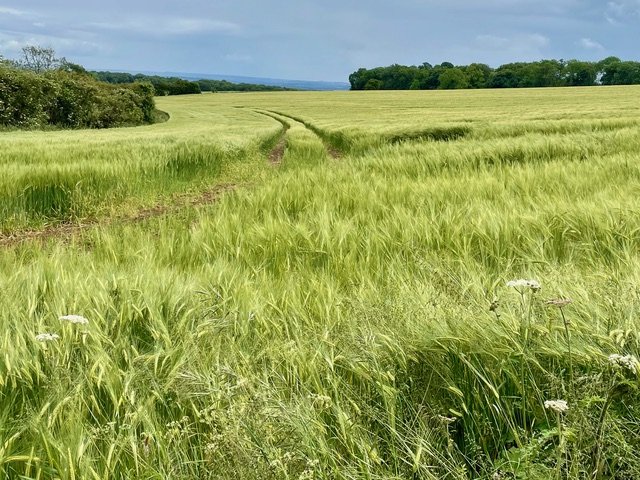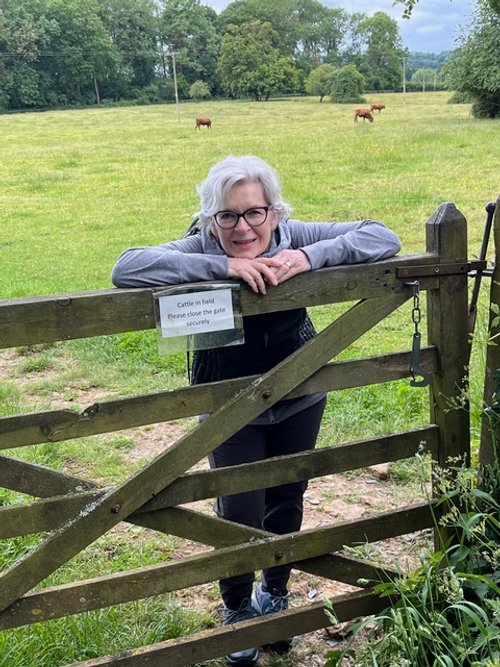Discover The Cotswold Way: A Long Distance Walking Journey
Walking the Cotswold Way
With the sole (or “soul”) job of putting one foot in front of the other… again and again and again…long-distance walking is renowned for its ability to rejuvenate the mind, body, and spirit. Whether you approach it as a very long hike, a mental reset, or even a pilgrimage, the experience of traversing miles of scenic landscapes on foot offers adventure with the time and space to nurture well-being.
As my research into the world of long-distance walking continues, I feel like a life-long apprentice - learning my way by “doing” as well as by listening with curiosity to the stories of fellow travelers.
Walking the Cotswold Way
The Cotswold Way caught my eye as a long-distance walk providing a taste of quintessential English countryside. The route is home to ancient castles, Neolithic burial grounds, idyllic villages and breathtaking views. When my friend Lisa recently returned from walking a portion of the Cotswold Way with her husband, I was curious about her trip and she kindly agreed to let me interview her about her experience. I asked Lisa questions about her experience based on the travel planning approach I use personally and share professionally in my travel coaching.
Cotswold Way Map - credit to Cotswold Way Association
The Cotswold Way
Description: Through charming little market towns connected by lanes and farmers' fields following the Cotswold escarpment.
Full Route: Chipping Campden to Bath (a world heritage city)
Overall Length & Difficulty: 102 miles / 164 km; easy/moderate
Like ANY and ALL journeys, the Cotswold Way can be completed however you like! There is no ONE RIGHT WAY to walk it. I believe that a traveler should design a trip to align with personal intentions and interests. So acknowledging this bias, let me share Lisa’s story to illustrate how you might personalize a long-distance walking journey for yourself.
Blog photography credits: Lisa and her husband
Meet Lisa who went on this trip with her husband. She was drawn to the Cotswold Way after a friend spoke about staying in Chipping Camden, UK, and taking daily out and back walks to various areas, and how much she enjoyed it.
LISA: “Other friends have done walking or hiking tours all over the world and rave about their experiences, so for our first walking tour, I thought the Cotswold Way would offer a chance to see the English countryside, enjoy quaint towns, and walk between them on a schedule that would not be too taxing.
Our planned purpose was to immerse ourselves in the English countryside and enjoy a restorative week of quiet companionship. We were drawn to the idea of a self-guided Cotswold Way tour that offered a peaceful escape from everyday life, allowing us to connect with nature, explore, reflect, and enjoy each other's company. It would be a blend of relaxation, curiosity, and a chance to slow down and experience the countryside at our own pace.
The intention was simple: to explore the Cotswolds at a leisurely pace while enjoying the quaint towns, picturesque landscapes, and historic landmarks. We would walk between towns, take in the surroundings, and have time for meaningful conversations. This trip was about being present, enjoying the countryside’s rolling hills, and experiencing something new while nurturing our well-being through walking and quiet moments together.”
Purposeful Travel and Being Intentional
The Travel Bug Tonic Travel Planning Approach (too much of a mouthful !!) starts with identifying the purpose of a trip and setting some intentions. I’ve learned that I enjoy experiences when they are connected to something meaningful. It doesn’t always have to be deep and transformational and can simply be just to let loose and have some fun, but interesting research on hedonic (pleasurable) and eudaimonic (meaningful) travel shows that travel with some kind of purpose boosts life satisfaction.
Among the many reasons why people choose to go on long-distance walking trip such as the Cotswold Way, here are some common ones:
Connecting with Nature
In Great Britain, the rights of walkers on traditional routes are protected, so you can walk across “private” property, including through farmer’s fields. The farmers have to ensure that the path is maintained. In return, you are expected to be very considerate — leave a gate open if you find it open and make sure to close it again if you find it closed.
Studies consistently show that spending time in nature reduces stress, improves mood, and even boosts cognitive function. Long-distance walking, by its very nature, is an immersion in the outdoors for extended periods, offering a much-needed antidote to the hectic pace of everyday life.
In the case of walking in The Cotswold Way, walkers traverse south-central England through farmer’s fields and picturesque villages. It is a place where nature and old-world British culture charmingly intersect.
Fitness and Physical Challenge
Walking for multiple days builds endurance, strength, and stamina, giving walkers a sense of accomplishment as they push their limits. These journeys provide an opportunity to engage in active travel while enjoying beautiful landscapes.
The Cotswold Way route offers gentle yet rewarding rolling hills, perfect for building fitness without being overly strenuous. Manageable daily distances along well-marked paths allow walkers to explore with ease.
Experiencing Different Cultures and History
Walking is a slow travel approach to experience places rich in cultural and historical significance. Walking between towns allows people to see historic landmarks, engage with local cultures, and discover the stories that shaped the area.
The Cotswold Way meanders by ancient churches and historic sites such as Sudeley Castle and Broadway Tower. Walkers pass through landscapes that have inspired centuries of British literature, art, and tradition.
A Break from Routine
Long-distance walking trips provide a break from the routines and pressures of everyday life. These trips offer an escape from technology, work, overwhelming responsibilities, and the fast pace of modern living, allowing for a slower, more immersive travel experience. Walking encourages living in the moment and enjoying simplicity.
Lisa found that walking The Cotswold Way exceeded her expectations in this regard. She told me that the trip felt like a time set aside for no worries and for relaxing in to the moment both on her own and with her husband. They relied on a tour company’s planning while still feeling in control of their travels.
…or maybe you want to walk just for fun! Read my article on travel FUN here!
LISA: “After spending a few days in London, we took a train to Moreton-in-Marsh, which served as the starting point of our self-guided walking tour. The plan was to follow the Cotswold Ring, a circular route through several charming towns over one week. We stayed in local inns and bed-and-breakfasts, which were pre-arranged by the tour company, Cotswold Walks. At the end of the tour, we returned to Moreton-in-Marsh to catch the train back to London, making the journey seamless and stress-free.
I chose Cotswold Walks, a family-run business, because I love that they were local and that they offered a series of webinars about various walks - guided and self-guided, so by the time I booked with them, I felt I knew the company.”
Travel Logistics: How will I get there, where will I stay, and how will I get home?
There are many different ways to design a long-distance walking holiday. I cover some of the options in this article.
Here are a few first questions to ask yourself:
Will I complete all or a portion of the walk?
Will I book accommodations myself or enlist the expertise of a tour company?
Will I walk self-guided or go with a guide?
What are the logistics of getting to the start of the trail?
Will I carry everything on my back or use a luggage transfer service?
Lisa’s research led her to confidently book a self-guided tour covering a portion of the Cotswold Way that most appealed to her. The tour package took care of logistical elements like hotel booking, rides, connections, and luggage transfers. Maps were provided with detailed notes about the kind of gates you would see, local history, and where to turn, as well as a GPS app. With luggage moved each day, they could walk less encumbered with just a day pack.
LISA: “The itinerary was personalized with extra care. While the core route took us through the charming towns of Stowe-on-the-Wold, Bourton-on-the-Water, Winchcombe, and Broadway, we took small detours, such as visiting the historic Donnington Brewery. A highlight included the view from Broadway Tower which was stunning. We were delighted to catch a glimpse of the steam train that operates in the valley. My favourite town was Broadway, but the 8 Bells Pub in Chipping Camden was our favourite pub!
I’d never done a multi-day walking tour before (although we do walk daily with our dog and enjoy local hikes) and I found that it exceeded my expectations. Choosing to let go of the logistics and relying on the tour company to handle accommodations, luggage, and transportation also felt like a luxury that allowed us to focus on the experience rather than the details.”
Personalize it - The Cotswolds “My” Way
Every traveller is unique, with different motivations, preferences, and needs. Travel, therefore, is not a one-size-fits-all experience. What may be a deeply restorative and meaningful journey for one person could be less fulfilling for another. The Cotswold Way walk, with its gentle landscapes and historical charm, might resonate deeply with those seeking tranquillity, connection, and cultural immersion. However, others might find their sense of well-being in more challenging, adventurous, or socially engaging travel experiences. Previous experience with thru-hiking and comfort in releasing control over logistics will vary from person to person. Many self-guided support companies are flexible and will work with you to allow further customization of your trip, but the walk can also be entirely organized by yourself. In Lisa’s case, she valued the luxury of someone else taking care of details.
LISA: “This beautiful, memorable trip allowed for quiet reflection, conversation, and a deep connection with the natural world. Walking in the Cotswolds was restorative and a welcome contrast to the hustle of London. The weather was ideal for walking, and the scenery was breathtaking, from rolling hills to picturesque towns.
Overall, it was a journey that satisfied both my curiosity and need for escape, and it strengthened the connection between my husband and me. Walking in the Cotswolds was one of the best trips we’ve taken together. We returned feeling refreshed, having experienced a week of adventure, relaxation, and meaningful travel.”
The key to a truly enriching travel experience lies in understanding your own needs and desires before setting out. Take the time to set pre-trip intentions and gain clarity on what you hope to achieve. You can then tailor your travel plans to better meet those goals. In the end, the most rewarding travel experiences are those that reflect who you are as a traveller.
Do your research, as Lisa did, to create the kind of experience that is most meaningful to you. If you need help figuring out what kind of trip you are after, and cutting through the overwhelm of the information, options, and services out there - please reach out.
Not into long-distance walking? Check out other ways to get a taste of the Cotswolds!
Pin it for later!
I hope this article helps you to plan your next adventure! Looking for more guidance?
TRAVEL COACHING: Need a bit of travel support to get you started or to fine-tune your travel plans? I’d love to work with you. Check out what travel coaching with me is all about and let’s connect!








